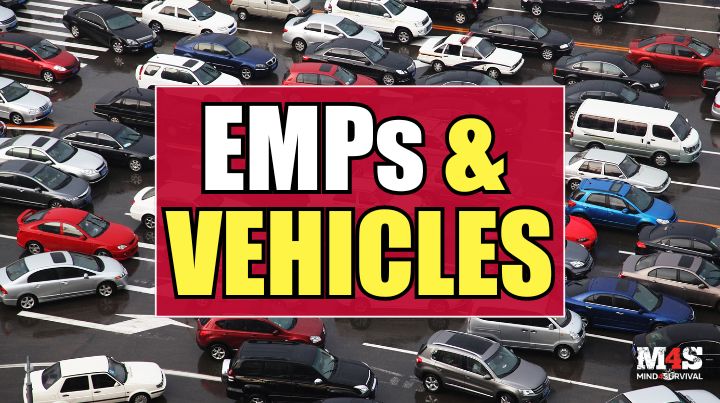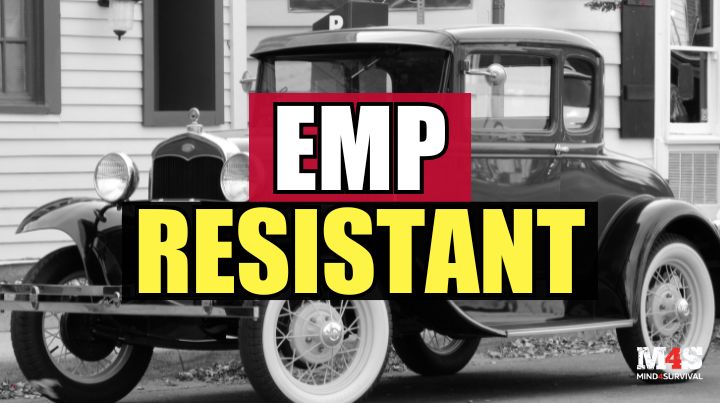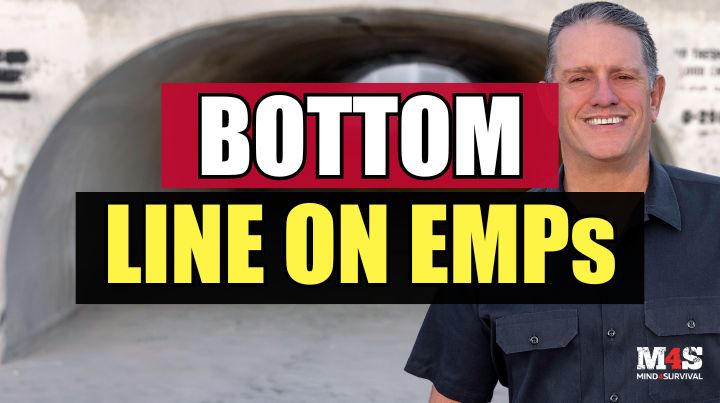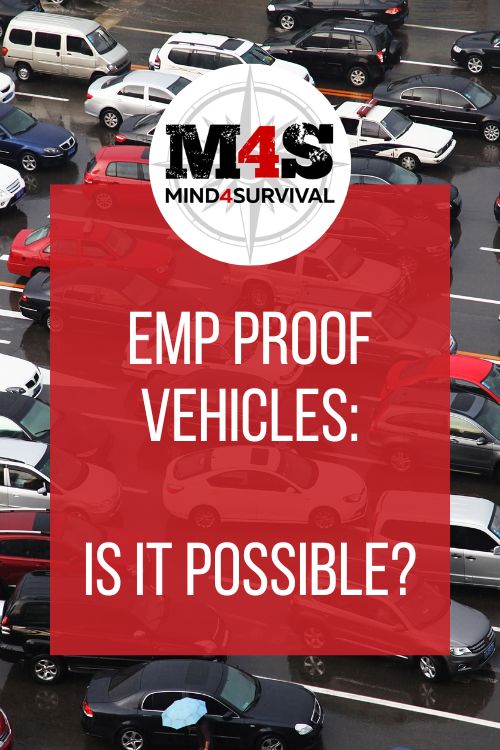EMP Proof Vehicles: Is It Possible? (EMP Vehicle Tips)

In an age where the potential of electromagnetic pulse (EMP) attacks loom, ensuring the resilience of our vehicles is a pressing concern. But what vehicles can actually survive an EMP? Are modern cars equipped with electronic components vulnerable? Can other cars and military vehicles withstand the onslaught of electromagnetic waves unleashed by a nuclear EMP or a solar flare? And most importantly, is there a way to protect your car from the devastating effects of an EMP attack?
This article is based on my discussion with EMP expert Dr. Arthur Bradley. Dr. Bradley is a former airborne infantryman and current NASA engineer who has conducted in-depth research into EMPs. His research provides a solid foundation for understanding the potential havoc of EMPs and how to prepare for them.
Let’s examine these critical questions and explore the most current information about EMPs and their effects on vehicles.
What is an Electromagnetic Pulse (EMP)?
In an era where every aspect of daily life depends on electronics, the concept of Electromagnetic Pulses (EMPs) is a stark reminder of our vulnerabilities. EMPs, resulting from nuclear explosions high in the atmosphere, have the potential to disrupt or destroy electronic devices and critical infrastructure. Identified in the 1950s, the threat posed by EMPs has escalated with our increasing dependency on digital technologies. The evolving risk of EMPs demands that we critically examine our preparedness to counter such a catastrophic event. Unfortunately, outside of the preparedness community and a few other areas, prepping for EMPs is not something many consider.
The historical and scientific context of EMPs illustrates their capacity to inflict widespread damage. Drawing from incidents and tests conducted in the past, it is evident that EMPs can severely affect both military and civilian electronic systems. The debate on the potential aftermath of an EMP event spans a spectrum of outcomes. Some believe an EMP will result in devastating long-term blackouts. Other believe it will lear to temporary disruptions. Regardless, the impact of an EMP, small or large, could significantly impact society. This highlights the complexity of predicting and preparing for the impacts of EMPs and the pressing need to implement resilient and protective measures individually and as a society.
Despite the recognized threat, the civilian infrastructure’s lack of readiness for an EMP strike is very concerning. While the military has made strides in safeguarding its assets, society, as a whole, appears ill-prepared. This lack of preparedness points to a critical gap in our defense against EMP threats. That gap emphasizes the need for individual and community-level preparedness.

Understanding EMP Waves
Electromagnetic Pulse (EMP) waves are categorized into three main components: E1, E2, and E3. Each wave component differs in terms of its characteristics, power and effects on electronic systems.
The E1 wave, known as the “fast” component, is characterized by its rapid onset and short duration, typically lasting less than a microsecond. This high-intensity pulse induces voltage spikes in electrical conductors, causing damage to sensitive electronic components such as integrated circuits.
The E2 wave, also called the “intermediate” component. It follows the E1 wave and has a longer duration, ranging from microseconds to seconds. While less intense than the E1 wave, the E2 wave still threatens electronic systems by inducing sustained currents of electricity and causing further damage.
In contrast, the E3 wave, known as the “slow” component, has a significantly longer duration, ranging from seconds to minutes or even hours. The E3 wave is what a coronal mass ejection (CME) is comprised of. While the E3 wave damages power grids and long conductive structures, it typically does not directly affect vehicles or delicate electronic systems.
Instead, the combined effects of the E1 and E2 waves pose the most significant threat to vehicles, as they can induce damaging currents and voltage spikes in electronic components, potentially disabling critical systems and rendering vehicles inoperable. Therefore, mitigating the effects of the E1 and E2 waves through EMP protection measures is essential to ensure the resilience of vehicles against electromagnetic threats.
What Vehicles Can Survive an EMP?
Vehicles produced before the widespread use of electronic control systems, typically before the mid-1980s, are characterized by their mechanical simplicity. This lack of reliance on delicate electronics makes them less susceptible to EMPs. As such, older car models are more reliable against EMPs than modern vehicles.
Therefore, for individuals invested in personal and family preparedness, the choice of what vehicle to own becomes a significant decision. A vehicle’s ability to withstand an EMP could mean the difference between being stranded and maintaining the capability to move to safety, access resources, or reunite with loved ones.
Thus, considering older, simpler vehicles is crucial in the face of a nuclear explosion or catastrophic electromagnetic event. This drives a practical approach to vehicle selection, encouraging preparedness-minded people to focus on models prioritizing mechanical functions over electronic sophistication. It’s not just about having a means of transport but ensuring that transport remains reliable if everything goes belly-up.
Beyond the initial choice of vehicle, the focus on EMP preparedness also encourages a deeper engagement with vehicle maintenance and modification practices. For those who prioritize resilience, understanding and enhancing the EMP resistance of their vehicle becomes vital. This might involve learning how to shield sensitive components, stockpiling spare parts that are likely to be affected by an EMP, or even modifying a newer vehicle to reduce its electronic dependencies.
My Truck’s EMP Protection
On a personal note, this is my situation. I drive a very modern, fully loaded-truck. Everything on my truck, from the running boards and heated seats to the ignition system, is made of delicate electronics. Therefore, rather than ignoring the problem, I am installing ferrite T.R.A.P.S. in my truck over time to protect it. The T.R.A.P.S. helps absorb the EMP energy and, hopefully, prevents that energy from overloading the electrical systems.
Efforts such as this reflect a broader strategy among preparedness-minded people to not only anticipate potential disruptions but actively prepare for them in a way that maximizes self-sufficiency and resilience. In this light, the consideration of a vehicle’s EMP survivability is symbolic of a holistic approach to preparedness. A holsitic approach evaluates every aspect of one’s life and resources for the potential to withstand the unexpected.

What Year Vehicles Are EMP Proof?
Identifying “EMP-proof” vehicles presents a challenge due to the varied nature of vehicle electronics and their responses to electromagnetic pulses. Generally, vehicles produced before the widespread adoption of electronic control units (ECUs), roughly before the mid-1980s, are considered less vulnerable to EMPs.
As stated, these older engine models rely on mechanical systems for functions such as ignition and even fuel injection and delivery, needing more complex electronic networks in newer vehicles. This lack of dependency on sensitive microelectronics means that these vehicles have a natural resistance to the immediate disabling effects of an EMP.
However, the transition from mechanical to electronic systems took time, and there’s a grey area in vehicles manufactured during the transition period. Some cars from the late ’80s and early ’90s may have a mix of electronic and mechanical systems.
While they incorporate ECUs, their electronic components are not as integrated or critical as in later models. In turn, this may offer a middle ground in EMP resilience. It’s possible in such a scenario, for example, that these vehicles may experience some electronic failures but maintain enough power and mechanical functionality to remain operable.
Do Not Focus on a Vehicle’s Year
For those concerned with EMP preparedness, focusing on the vehicle’s engine and electronic architecture rather than its manufacturing year might offer a more accurate gauge of its survivability. Simple diesel engines, for instance, rely less on electronic ignition systems. Therefore, they may provide an alternative regardless of their year of manufacture.
Ultimately, while older vehicles generally stand a better chance against EMPs, evaluating modern vehicle-specific electronic systems and considering modifications to enhance their EMP resilience could be a more practical approach for those looking to prepare.
It’s also worth mentioning that there are many variables and unknowns regarding EMPs. The fact is, we’ve never experienced an EMP that was directed at disabling our grid and electrical systems. Likewise, a vehicle’s survivability also depends on variables such as where it is stored or its position in relation to the EMP. The bottom line is that no hard-and-fast rule states that every vehicle, new or old, will be destroyed. Therefore, I imagine the truth lies somewhere in the middle.

Are Military Vehicles EMP Proof?
Military vehicles have long been subjected to stringent testing to withstand the threat of electromagnetic pulses (EMPs). Despite these efforts, it’s crucial to understand that while military vehicles incorporate EMP protection capability, they aren’t entirely immune to such threats.
One notable EMP testing facility from the 1970s is the “Trestle.” The Trestle is a massive wooden structure built explicitly to assess the resilience of military equipment against EMPs. This facility, constructed entirely of wood to prevent interference with electromagnetic fields, played a pivotal role in evaluating the vulnerability of military vehicles and aircraft.
The Trestle facilitated real-world testing scenarios, allowing engineers to gauge the effectiveness of various protective measures against EMPs. While military vehicles may boast enhanced shielding and resilient electronic systems designed to mitigate EMP effects, the ever-evolving nature of EMP threats necessitates continuous advancements in protection technology.
In short, military vehicles undergo rigorous testing and are equipped with certain levels of EMP protection. However, they aren’t impervious to EMP damage. The lessons learned from facilities like the Trestle highlight the ongoing need for strong defense systems and proactive measures to mitigate the risks posed by electromagnetic pulses in today’s ever-evolving threat landscape.
Is There a Way to Protect Your Car from an EMP Attack?
Protecting your car from the devastating effects of an EMP attack is a critical consideration in today’s modern technological landscape. While the potential of such an event may seem daunting, there are practical steps you can take to fortify your vehicle against electromagnetic pulses. One effective method is installing EMP protection technology, including shielding to absorb and dissipate the energy. These innovative solutions act as a barrier, protecting electronic components from the harmful effects of EMP waves.
Furthermore, integrating transient protection devices and ferrites into your vehicle’s electrical system can provide an added layer of defense. Dispersing excess energy and suppressing voltage spikes help safeguard modern car and critical electronic systems from potential damage. Considering the increasing complexity of modern vehicles and the vulnerability of their electronic systems, it’s essential to take proactive measures to increase your car’s ability to withstand an EMP attack.
Comparing EMP Protection Solutions
When considering EMP protection measures for your vehicle, it’s essential to weigh the pros and cons of different solutions. Faraday cages and EMP shields offer great protection against electromagnetic pulse pulse. Likewise, transient protection devices such as ferrites provide additional layers of defense against transient energy surges. By comparing the features and effectiveness of various EMP protection solutions, individuals can make informed decisions to safeguard their vehicles against EMP threats.
5 Tips for Protecting Your Vehicle Against EMP Attack
The specter of electromagnetic pulse (EMP) threats continues to loom. This means that equipping your vehicle with the necessary defenses against such scenarios is a paramount concern. In this section, we’ll explore practical tips for EMP preparedness, offering actionable advice to safeguard your vehicle against electromagnetic pulses.
1. Consider Older Vehicles: Opt for vehicles manufactured before the mid-1980s. They rely less on delicate electronics and are inherently more resistant to EMPs.
2. Evaluate Electronic Architecture: To accurately assess a vehicle’s EMP survivability, focus on its electronic architecture rather than its year. Considering other factors, like diesel engines’ simplicity. Choose vehicles with mechanical systems for critical functions like ignition and fuel injection and delivery. Reduce reliance on electronic components vulnerable to EMP damage.
3. Compare and Implement EMP Protection Solutions: Evaluate the effectiveness of different EMP protection solutions such as EMP shields and transient protection devices. Choose and install the most suitable option for your vehicle and situation. Consider installing ferrite T.R.A.P.S. to absorb EMP energy and prevent overloading of the battery and electrical systems.
4. Prepare to Repair: Be ready to repair the damaged electrical system. Keep a reasonable stockpile of spare parts on hand and know how to change them
5. Stay Informed: Stay informed about the latest developments in EMP protection technology. Explore EMP protection measures to safeguard your vehicle effectively against electromagnetic threats.

The Bottom Line on EMP Proof Vehicles
In conclusion, the concept of an EMP-proof vehicle may seem elusive in today’s ever-evolving technological landscape. However, taking proactive steps to protect your car against electromagnetic threats can significantly enhance its chances of EMP attack survival.
Whether retrofitting older vehicles with EMP protection technology or implementing safeguards in modern cars, ensuring the resilience of our vehicles against EMPs is critical for preparedness. So, buckle up and dive into EMP protection to safeguard your ride against the unseen perils of electromagnetic warfare.
What are your thoughts on protecting your vehicle against EMPs? Have you started? Tell us about it in the comments below.
Additional Resources
- What Does an EMP Do? EMP Expert Arthur T. Bradley FACTS!
- What is an EMP? The Expert Guide to Electromagnetic Pulses!
- EMP Truth: What You ACTUALLY Need to Know! (Video)
Stay safe,


Don't Miss Out!
Join the thousands of people who rely on Mind4Survival preparedness advice by subscribing to our FREE newsletter.
- Practical preparedness information
- Zero Spam
- < 0.25% of people unsubscribe




Join Mind4Survival!
Stay informed by joining the Mind4Survival! 100% Secure! 0% Spam!
Follow Us!
Affiliate Disclosure
Mind4Survival is a free, reader-supported information resource. If you make a purchase through our link, we may, at no cost to you, receive an affiliate commission.

